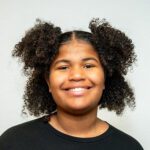Meet me! A twelve-year-old “They/Them?” or something like that, in the 7th grade. You know nothing about me, but would you want me to be bullied? No, you wouldn’t. So why should queer youth get bullied just because they’re different from you? I don’t wish for me and other queer youth to walk into school or an after-school program feeling scared or nervous just because we’re different from the majority of our peers. Bullying me because of my gender or sexuality affects my mental health and makes me question myself. Bullying towards queer youth increases their chances of mental health issues and suicide. So, to reduce this problem, teachers and school administrators should set up more after-school programs and safe spaces to support queer youth.
According to a 2020 article released by the Human Rights Campaign, an LGBTQ+ advocacy group, “The data show that 43% of transgender youth have been bullied on school property. [In addition], 29% of transgender youth, 21% of gay and lesbian youth, and 22% of bisexual youth have attempted suicide.” Bullying toward the queer youth can come from anywhere and in several forms. It could be from classmates, teachers, family, or friends, and it could be verbally, online, and physically. I’ve felt out of place enough, and the bullying makes it worse. As someone under the trans umbrella, I can’t stress enough that the bullying needs to stop before it gets too far. Jot Turner and Brianna Ghey were two trans youths; one died by suicide, and the other was killed because of bullying directed at them because of their gender. Their stories show that this bullying can become serious. I know that if this continues, someone you know or I will contribute to the statistics.
Based on this problem, creating safe spaces in schools and communities and also educating straight, cisgender people about the queer community will lessen the rates of bullying and suicide among LGBTQ+ youth. According to the CDC’s “Supporting LGBTQ+ Youth” recommendations, understanding how sexual orientation and gender identity are defined and how the two differ is the first step in building a safe environment.
One after-school program in DC that helps queer youth is the “Sexual Minority Youth Assistance League,” or SMYAL. According to their website, SMYAL.com, “SMYAL supports and empowers lesbian, gay, bisexual, transgender, and questioning (LGBTQ) youth in the Washington, DC, Metropolitan region. Through youth leadership, SMYAL creates opportunities for LGBTQ youth to build self-confidence, develop critical life skills, and engage their peers and community through service and advocacy. Committed to social change, SMYAL builds, sustains, and advocates for programs, policies, and services that LGBTQ youth need as they grow into adulthood.” This type of program doesn’t need to be limited to after-school hours. According to the Centers for Disease Control’s article, “Teachers and school staff can promote positive changes within school environments that address health disparities and help LGBTQ+ youth thrive in school.” The way teachers and administrators can help is mentioned in Florida State University’s Health and Human Services Department, which elaborates that instructors can do things like hang up pride flags around the school building or on their personal belongings. At their first class, they can say their preferred name and pronouns. Most importantly, they can address any homophobic and transphobic bullying or comments. These pieces of advice help because they give students a sign that they can be safe in that area. A subtle sign can go a long way for those students and youth.
As you can see, queer youth have a higher risk of being verbally and physically harmed. After-school programs and safe spaces in school will reduce these rates because they bring a feeling of security and show that there are others like them. In the future, I hope that the idea I have stated will be expanded upon and reduce the percentage of those being bullied and taking their lives so those like me in the queer community will have the safe spaces we want, need, and deserve.
